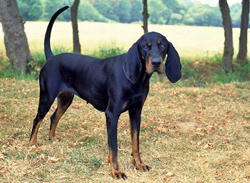Black and Tan Coonhounds are determined hunters with good muscle tone and alert, eager expressions. Their short and dense coat is coal black with tan markings on the sides of their chest, legs, muzzle, and breeching. Their eyes are hazel to dark brown, and their long ears are low set. These dogs measure 23 to 27 inches tall at the shoulder and weigh 65 to 100 pounds. With proper care, Black and Tan Coonhounds live up to 12 years.
This breed has a musty odor that some people find unpleasant. Regular baths will help reduce this odor, but there's no way to completely eliminate it. To ease odor, bathe these dogs with a pH balanced dog shampoo approved by a veterinarian.
This American born and bred dog breed takes its name from its coloring and purpose, which is chasing and treeing raccoons. These dogs are great with kids and mellow and calm indoors. They make excellent family pets, although their tendency to howl and bay may disturb neighbors.
Black and Tan Coonhounds are prized for their amazing nose and ability to follow even cold trails. Their trailing ability is superior to most other dogs.
An affectionate, friendly, and outgoing breed, Black and Tan Coonhounds enjoy being around people and like the company of other animals. These dogs are great with kids, dogs, and cats, and they are even accepting of strangers. Because Black and Tan puppies are rambunctious, these dogs might not be safe around toddlers and small children.
These dogs need moderate daily activity in a securely fenced yard or on a leash. However, they are laid back when indoors and make good pets even for more sedentary families, provided they are given opportunities to run and play on their own. They could run for miles, but they are satisfied with long walks or moderate jogs.
Black and Tan Coonhounds are intelligent and adaptable dogs who enjoy mental stimulation, but they also like to lie around and watch television with their human companions. The breed does have a tendency to be persistent and stubborn, and they have no moral objection to stealing food at every possible opportunity.
Black and Tan Coonhounds are a generally healthy breed. However, these dogs are more likely to suffer from hip dysplasia and certain eye problems, including entropion and ectropion, than some other breeds are. The breed is also prone to hemophilia B, a severe bleeding disorder.
The breed's natural instinct to follow trails may predispose it to a condition called Coonhound paralysis. This disorder causes nerve inflammation and is associated with raccoon exposure. The breed's floppy ears are prone to infection, and hunting puts these dogs at risk for torn toenails, broken toes, and split footpads. The coat must be checked for ticks every time the Black and Tan comes indoors.
Routine veterinary care, timely vaccinations, proper nutrition, and regular exercise help ensure Black and Tan Coonhounds live a full life of 12 years.
Black and Tan Coonhounds are not known for being trainable. These dogs are very stubborn and easily discouraged, and these traits may interfere with the training process. To improve success, begin training early in life and keep sessions short and fun to hold the breed's attention. Black and Tan Coonhounds are especially fond of food rewards, and these can be used to improve training success.
This breed tends to bark a lot and has a strong instinctual urge to chase and tree cats and other small animals. Training can help these behavioral problems. Controlling behavior and establishing rules must begin very early, as this breed has a hard time unlearning negative behaviors.
Black and Tan Coonhounds need about 30 minutes of walking, twice daily. They must be walked on a leash to keep them from running off to follow scents, and they should be enclosed in a securely fenced yard when not on a leash. These dogs can be indoor or outdoor dogs, but they will quickly become lonely without attention from their human families.
The Black and Tan's short coat is easy to groom. It should be brushed with a rubber curry brush or hound mitt a few times each week to distribute skin oils throughout the coat and to remove dead and loose hair. These dogs tend to shed a lot, but frequent brushing can reduce the amount of hair that ends up on furniture.
This breed has a musty odor that some people find unpleasant. Regular baths will help reduce this odor, but there's no way to completely eliminate it. To ease odor, bathe these dogs with a pH balanced dog shampoo approved by a veterinarian. The breed must be rinsed thoroughly after bathing, as shampoo left on the coat and skin can lead to dry, flaking skin and other problems. A weekly wipe down is sufficient if odor is not a problem.
The ears should be checked weekly for signs of infection, and they need to be dried promptly after swimming to prevent skin irritation and infection. The nails should be trimmed every few weeks, and the teeth need regular brushing to maintain gum and tooth health.
Black and Tan Coonhounds likely descended from the Talbot Hound and the Bloodhound. In the United States, the breed evolved from Foxhounds that possessed the black and tan coloring and the treeing instinct. Like other Coonhounds, these dogs were primarily used to trail and then run raccoons up trees.
The breed was developed in the southern United States and then owned by Indian fighters and scouts during the late 18th century. It was the first of the Coonhounds to be recognized as a separate breed by the AKC.
While the breed has historically been used for trailing and treeing, these dogs are also excellent at hunting mountain lions, bears, deer, and other large game. They also make wonderful companion animals and do well at dog sports and showings.
The American Kennel Club officially recognized the Black and Tan Coonhound in 1945.

